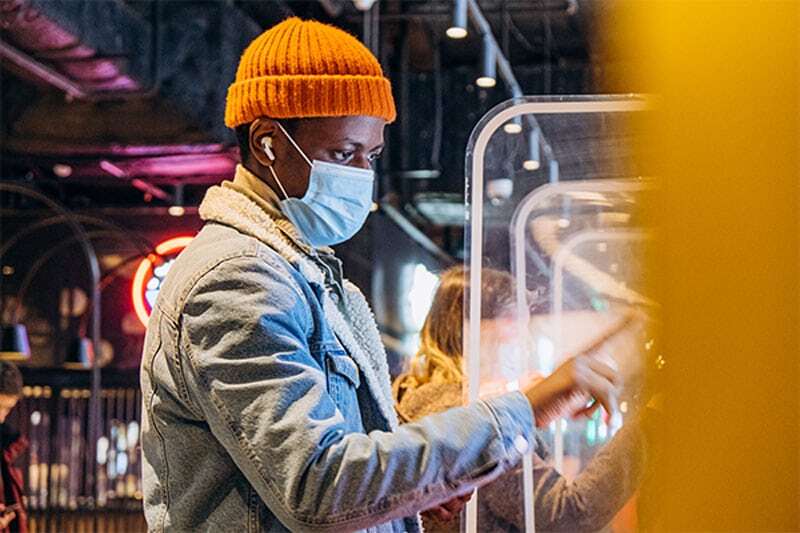The Importance of Customer Experience in 2022
Published on Jan 25, 2022

Providing a great customer experience (CX) has long been prioritized by brands wanting to differentiate from the competition. Companies that continue to recognize the importance of customer experience—and prioritize investments and actions that generate high customer satisfaction and establish strong brand loyalty—will be the ones to come out on top in 2022.
Major disruption is occurring for customer experience management, spurred by the pandemic and sustained through evolved consumer habits that are here to stay. This disruption is only elevating the importance of customer experience, but it can be a real challenge for CX practitioners to know what to prioritize to meet their customers’ expectations. The target keeps moving, and teams face increasing internal pressure to deliver business outcomes and ROI with their customer experience program.
As SMG embarks on a new year with the 500+ brands we partner with to deliver a positive customer experience, we predict the following CX trends will guide priorities in 2022.
CX trend #1: The digital transformation is dead—witness the rise of human-centered tech
Over the past few years, companies have amped up their digital efforts to meet the needs of consumers and provide exceptional customer service. But many brands jumped in without a thoughtful strategy in place—launching overreaching IT investments and futile branded apps that did little to enhance the customer experience.
While it’s easy to confuse outdated ideas with innovative approaches, brands that tackle this increasingly necessary adoption the right way can optimize the technological offerings available to them without disrupting digital CX.
What is “the right way?” Forrester predicts it’s “tech execs leaping from digital sameness to human-centered technology transformations.” 2022 is all about enriching customer personalization—while keeping privacy sensitivities in mind.
It’s also about drawing a true connection between employee and customer interactions—which is what UK-based company Co-op set out to do when it introduced a video feedback solution to its existing CX program. Video feedback helped show the humanity behind CX data, allowing employees to hear directly from customers rather than getting filtered feedback from a manager.
The new video comment option was a success and helped Co-op collect more feedback and richer insights—answering key business questions, providing opportunities to recognize employees for outstanding service, and improving program engagement.
CX trend #2: Customer feedback collection is evolving to real-time customer journey experience management
Gone are the days of a customer journey that follows the traditional top-to-bottom funnel. Today’s consumers engage with brands when and how they want, evolving from a transactional process focused simply on shopping and buying, to a model built on deep, enriching relationships at every step of the customer journey.
This means brands without an agile customer experience solution in place—one that measures across physical and digital channels—will have trouble providing a positive experience at every touchpoint. And when customers have a disjointed experience, they see a disconnected brand.
To close the gap on cross-channel customer experiences and meet customer needs, brands should follow these steps:
Step 1: Define the customer journey from the customer’s point of view—not your brand’s
Brands often make assumptions about the customer journey rather than defining that journey through actual customer behavior. Remember: it’s the consumers who determine how they’ll interact with your brand and what they expect across channels. That’s why it’s imperative to understand the customer journey through the eyes of the customer.
To do this, map out all of your brand’s channels (e.g., in-store, online, click-and-collect, delivery). Then you can leverage experience feedback to determine customer expectations and common themes across those touchpoints.
When your brand has a more clearly defined customer journey in place, you will be better equipped to improve the experience across channels.
Step 2: Establish active and passive listening posts across the customer journey
Many brands are accustomed to looking at observational data and guessing what customers are experiencing. Then they employ changes they think will fix the issue, but don’t know what the customer wants.
Having a healthy mix of active (e.g., intercept surveys, micro surveys, post-engagement) and passive (e.g., feedback buttons, chat) touchpoints in your XM program ensures you’re listening across the customer journey from start to finish.
Additionally, through the use of self-serve capabilities, you can seamlessly control what you ask and when you ask it without technology overhead. Real-time deployment by non-technical resources makes it easier to increase the footprint of feedback channels.
This, in turn, greatly enhances the ability to identify a bad experience, eliminate points of friction, increase conversion, and provide seamless experiences across the journey. You’ll also get a holistic view—instead of looking at siloed engagements—which will help you uncover issues faster and close the loop across channels.
Step 3: Leverage experience feedback to uncover actionable insights and drive business outcomes
Customers will drive achievement across your company objectives if you let them—they can tell you what to fix. But simply collecting their feedback isn’t enough. You have to act on those insights in a way that drives meaningful change to your cross-channel efforts.
Brands often need a combination of strategic guidance, managed and professional services, and technology to embed insights into their business, inspire actions that improve CX, and deliver business outcomes.
The problem is, lots of CX vendors talk about insights, but few actually deliver—and a technology platform alone will only get you so far.
To really take advantage of true CX insights—the kind that boost loyalty and improve business performance—your team needs trusted CX advisors who have experience in experience management best practices that drive outcomes.
Step 4: Evaluate the cross-channel capabilities of your customer experience provider
As the customer journey continues to evolve and expand, brands must have a comprehensive experience management program in place to keep up. You need to understand what your customer is thinking—and without a way to collect real-time feedback across all touchpoints, you’ll miss those key insights.
Partnering with a software with a service (SwaS) provider means you’ll have ongoing, hands-on support to help your brand generate new revenue, grow existing revenue, reduce churn + detractors, and drive operational efficiencies.
CX trend #3: The employee experience is the pinnacle of CX insights
Just a couple years ago, the biggest fight brands faced was to beat their competitors and create loyal customers in a crowded marketplace. Today, the bigger battle is over who can win employees in a challenging labor market.
According to McKinsey & Company, last year’s record-breaking rise in job vacancies is due to employees being exhausted and overwhelmed, questioning what work means and considering their options.
The importance of improving the employee experience (EX) has never been more critical. In all climates, the quality of experience, wellbeing, and support of an organization’s employee base should be top priority. But it takes more than just listening—businesses must actively have conversations and act on what matters most to their workers.
Organizations that prioritize the delivery of great employee experiences are rewarded, both in the ROI of program investments and through the intangibles of workplace culture. Employees are more loyal, work harder, and champion employers who prioritize creating better workplaces. Additionally, satisfied and engaged employees consistently deliver better customer experiences.
Without an EX program that’s measuring the employee journey and tying program results back to business outcomes, it can be difficult for organizations to move the needle on key drivers of employee engagement and identify the best actions to attract, develop, and retain employees.
To understand what today’s employees are looking for, McKinsey’s research also found workers are hungry for trust, social cohesion, and purpose. Organizations that offer excellent, tailored, authentic employee experiences in 2022 can meet these needs while igniting new energy and elevating organization-wide performance.
And the payoff will be big—people who report having a positive employee experience have 16x the engagement level of employees with a negative experience, and they are 8x more likely to want to stay at a company.
CX trend #4: CX programs are moving beyond reporting to prioritize action and outcomes by leveraging predictive analytics
Too often, CX programs get sidelined as performance-trackers or diagnostics tools—collecting data that doesn’t appear on a meeting agenda until something starts flashing red. Scores fluctuate, reports get skimmed—but by and large, it’s business as usual.
Before you know it, you find yourself on the wrong side of the growing gap between brands that are simply aware of the data and those that are using it to surface insights that drive action and produce meaningful business results.
To translate mountains of data into actionable insights that lead to tangible business outcomes, every CX initiative you launch must be:
- Targeted: What is the specific CX focus of the business case you’re aiming for?
- Measurable: How much will the initiative cost, what are the projected benefits, and which KPIs will you track?
Data-driven CX programs struggle to prove ROI because they operate in hindsight—using correlation analyses to show retrospective relationships between scores and sales.
But insights-driven organizations thrive by leveraging prescriptive reporting to target specific areas for focus and using predictive analytics to go beyond assessing impact to project the specific outcomes that success will be measured against.
Whether it’s prioritizing actions in the field, forecasting trends, or mitigating operational risks across the enterprise, predictive analytics technology leverages machine learning to keep brands ahead of major issues. It’s about operating at the speed of the consumer and using that information to impact what happens next.
Most importantly, predictive analytics helps brands identify what matters to customers, mitigate operational risk, and stay ahead of high-impact, low-frequency events.
CX trend #5: With customer trust more fragile than ever, brands must work harder to win loyalty
Amid the pandemic, consumer priorities have shifted—placing more emphasis on a safe and healthy experience. Customers are no longer blindly loyal and are turning to brands that take the steps needed to regain their trust.
And earning customer trust has never been easy. EY ran a study in April 2020 and found less than a quarter of U.S. consumers said they completely trust brands (23%) and retailers (24%). Fast-forward one year later, and the trust picture is much worse. Only 10% of U.S. consumers completely trust online-only retailers and chain retailers while just 13% completely trust CPG brands.
And once trust is lost, companies risk losing the consumer completely. Forty-seven percent say when an organization damages trust, they decided not to purchase from them at all. At the same time, 28% of consumers will pay a premium to buy from brands they trust.
In addition to being diligent and transparent on health and safety measures, brands must also focus on sustainability measures to earn the trust of today’s consumers.
In one SMG study, more than half of the 27,000 consumers we surveyed said sustainability was important to them, and brands should be taking more action to protect the environment.
Additionally, Accenture argues companies are being scrutinized on their sustainability credentials like never before. Its research shows 66% of consumers plan to make more sustainable or ethical purchases in the next 6 months, and that employees, investors, and other stakeholders are equally if not more resolute. To be true “sustainable organizations,” the focus needs to go beyond the cosmetic to real change that’s embedded throughout an organization’s DNA.
What actions can you take to improve the customer experience from here?
If you’re reading this, you recognize the importance of customer experience. It’s just as important to understand where CX is headed—so you are equipped to make the right technology investments that enable you to develop a deep understanding of your customers across their unique purchase journeys.
Leading companies will invest in human-centered and predictive technologies that allow them to move beyond reporting and dashboards and fast-track to driving timely actions for customers and employees—delivering real outcomes and ROI for their business. And those on the leading edge will combine CX and EX measurement to create positive employee experiences while additionally leveraging employee feedback to generate CX insights.
Whether your experience management (XM) program has just recently launched, been live for decades, or is simply an idea at this point, it’s never the wrong time to evaluate how well your organization is listening to customers and employees and acting on those insights. Because if you’re not, there’s a big chance you’re falling short on expectations and customers are taking their business (and loyalty) elsewhere.
SMG’s unique software with a service (SwaS) approach means brands don’t have to go it alone. From day one of onboarding to reaching state-of-the-art program maturity, we provide support throughout your entire program lifecycle—combining platform technology with ongoing professional services that help you change the way you do business.
You deserve an XM partner that will deliver the level of support you need to change the way you do business. If you feel your current vendor may be falling short, let’s chat.
Want industry specific trends that will impact CX? Check out these 2022 industry trend reports
All the trends listed in this blog have one thing in common—customer-centricity. Designing customer-centered experiences requires you to additionally stay ahead of niche industry trends that uniquely impact your consumers and your business.
SMG recently assembled forward-looking restaurant and retail industry trends and insights based on data and consumer behavior to help brands anticipate new trends and consumer habits as they figure out how to prepare for the coming year. Download the report that best fits your brand.
Restaurant trends we’ll see in 2022
As challenges evolve and consumer demand returns to pre-pandemic levels, restaurant operators have little time to waste in the coming months to reestablish momentum, especially when a misstep or under-utilized technology solution could drive consumers elsewhere. Read more about the four restaurant trends we’ll see in 2022 and learn what they mean for your customer experience and employee experience practices.
Retail trends we’ll see in 2022
Though we’ve turned a corner on the tumultuous times in the height of the COVID-19 pandemic, residual impacts continue to burden the retail industry. From labor market and supply chain shortages to global economy challenges and climbing inflation, brands are facing a new set of make-or-break moments in the future of the retail industry. Read more about the four retail industry trends we’ll see in 2022 and learn what they mean for your customer experience and employee experience practices.
Related articles

Close the gap across touchpoints to deliver a consistent digital experience
Follow these 4 steps to advance your digital experience strategy, provide consistency at every touchpoint, and drive customer loyalty.

Why Are Retail Customer Experience Programs Failing? 5 Steps to Take to Improve
Many retail customer experience programs are struggling. These steps will help build a team and program that improves customer experiences and drives revenue.

Customer experience strategy best practices to keep up with 2023 CX trends
With the right customer experience strategy best practices, brands can best prepare for the evolving customer experience trends of 2023.